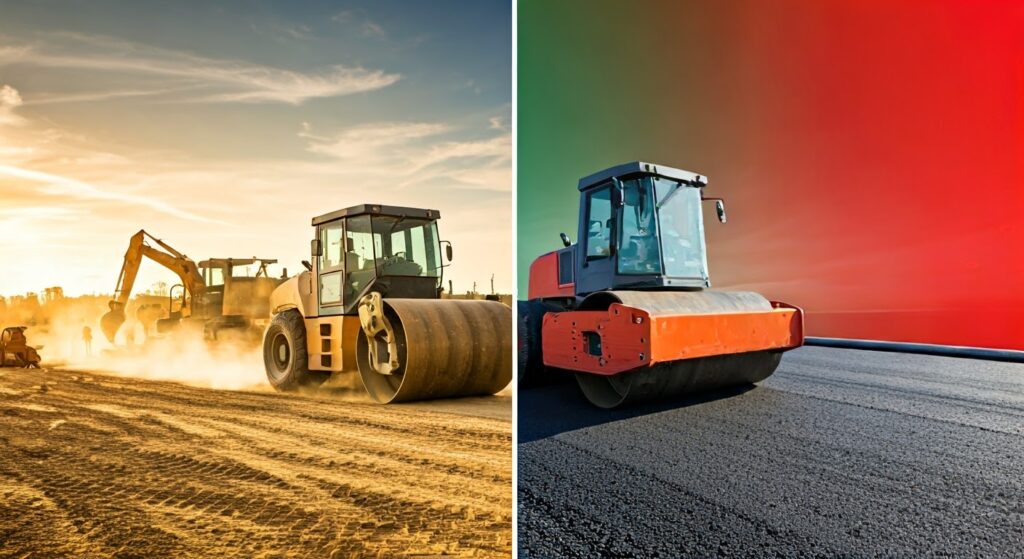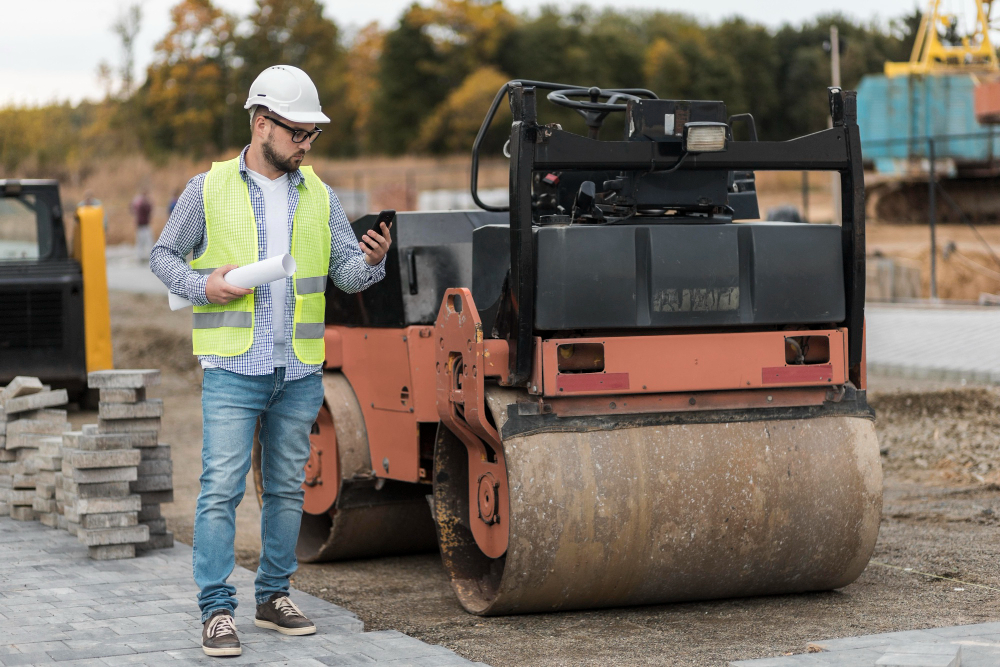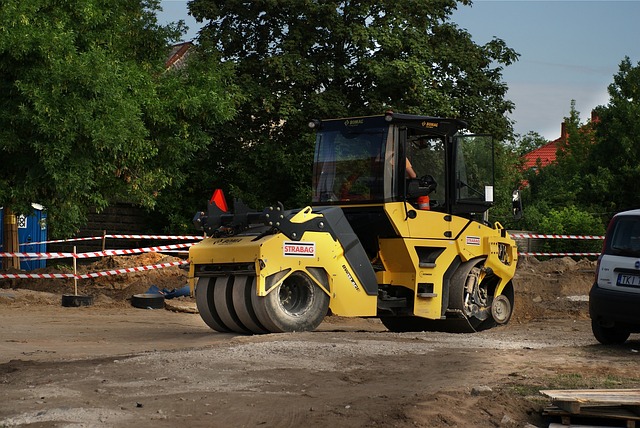Plate Compactor vs. Roller Compactor
Key Differences, Applications, and How to Choose
Which Compactor Is Best for Your Project? To maintain soil density and stability, both gardening and construction need for compactors. These machines crush asphalt, gravel, and soil to provide a solid basis for landscaping and road construction. Project lifespan, safety, and efficiency all depend on compactor performance. Success depends on choosing the proper kind of compactor from different types of compactors.
You have to understand their purposes and features if you are deciding between roller and plate compactors. Every kind provides advantages that help the project run better. Although roller compactors are better for extensive compaction, plate compactors are chosen for their agility in small areas.
To find the difference, this paper will contrast roller and plate compactors. Understanding these differences and their benefits will help readers to better choose kinds that satisfy their project requirements.
What Is a Plate Compactor?
Multipurpose soil and asphalt compaction compactors are plate compactors. A flat, heavy plate vibrates to increase the material density in these machines. The weight and vibration of the plate help to provide proper compaction under many conditions. For work site flexibility, plate compactors come in walk-behind and ride-on models. Their small scale allows them to operate in close proximity where larger machinery cannot.
The Plate Compactor’s Working Mechanism
A plate compactor—or vibratory plate—compresses materials by use of high-frequency vibrations applied by a heavy, flat metal plate. The engine drives a vibrating mechanism producing downward force, hence producing quick hits to close air gaps. This makes asphalt repairs perfect as well as cohesive and granular soils.
Common uses for small-scale projects are sidewalk pavers, trench backfilling using a plate compactor.
Common Applications of Plate Compactors
- Small-scale projects: Sidewalks, pavers, trench backfilling.
- Confined spaces: Tight corners, edges, or trenches.
- Asphalt repair: Sealing cracks or compacting hot mix asphalt.
Benefits and drawbacks of plate compactors
- Pros: Roller compactors perform less well in tight areas than plate compactors. Unlike roller compactors, which need more room, plate compactors are great in confined areas. Their adaptability qualifies them for small projects, utility trench backfill, and home landscaping. Faster mobilization and setup using plate compactors also help to increase work site productivity.
- Cons: loud operation; limited compaction depth; inappropriate for big areas.
While they lack the efficiency required on large areas, plate compactors shine in accuracy work. Their agility makes them a choice for home repairs or maintenance chores when space is limited.
What Is a Roller Compactor?
Essential building tools for compaction of asphalt, dirt, and other materials are roller compactors. For maximum density and stability, these machines crush the surface with a heavy cylindrical drum. Roller compactors must have size, weight, and the capacity to make many runs over the same area if they are to reach the proper compaction levels. For uses particular to a project, smooth drum rollers for asphalt and padfoot rollers for cohesive soils allow.
Working Mechanism of a Roller Compactor
A roller compactor (or road roller) compresses materials using the weight of a steel drum—static or vibratory. While smooth drum rollers employ simply mass, vibratory rollers mix static pressure with vibrations for deeper compaction. For bigger tasks, these machines may be found in ride-on or walk-behind types.
Common Applications of Roller Compactors
- Large-scale projects: Large-scale projects like highways, parking lots, embankments often call for roller compactors.
- Cohesive soils: Materials with cohesive soils—that is, those heavy in clay or silt—need constant pressure.
- Asphalt layers: reaching homogeneous, smooth surfaces.
Roller compactors: Pros and Cons
- Pros: Large-scale projects benefit much from roller compactors. Their ability to crush deeper than plate compactors qualifies them for heavy-load tasks. Additionally faster and more effectively, roller compactors help to cut project timelines. By saving time, this reduces labor costs and boosts work site output. Their adaptability as building tools also comes from their ability to compress pavement and stabilize ground.
- Cons: Overkill for little chores; costly; less mobile.
Although they are essential for infrastructure projects, their size makes roller compactors useless for limited areas.
Important Variations between roller and plate compactors
Working Model
- Plate compactor applies impact force and vibration.
- Relies on either vibratory drums or stationary weight in a roller compactor.
Rollers handle cohesive soils and thick asphalt layers; plate compactors are suitable for granular materials.
Compaction Depth and Force
- Designed for shallow layers, a plate compactor compacts up to 12 inches.
- Suited for deep foundations, compacts 18 to 24 inches are the roller compactor.
Project Accuracy and Scale
- Manual operation for a plate compactor slows down for bigger regions.
- Wide swathes rapidly covered by a roller compactor help to save work time.
Accessibility and Maneuverability
- Navigates small areas, lightweight plate compactor.
- Roller compactors call for open areas and challenging near-observation.
Maintenance and Financial Cost
- Lower upfront cost and little maintenance characterize a plate compactor.
- Higher investment and regular drum inspections define a roller compactor.
How to Choose Between a Plate Compactor and Roller Compactor
Choosing the right plate or roller compactor calls for understanding of their variations. To compress gravel, asphalt, and dirt, plate compactors move a heavy, flat plate. It performs well in confined places for exact compaction in limited areas. Roller compactors roll cylindrical drums over the surface, so they are appropriate for site preparation and road building. Which compactor to utilize depends on job size and specifications.
Depending on moisture and kind, plate comphers granular materials to 8–12 inches. They are quick, which helps operators to efficiently cover small areas. Although they produce less depth per pass, roller compactors cover great areas faster and complete asphalt. Large projects requiring quick, high-quality production fit roller compactors.
When weighing compacting techniques, maintenance and expense become important. Smaller contractors and do-it-yourselfers enjoy plate compactors as they are less expensive to start and easier to maintain. Roller compactors cost more initially because of their size and complexity, but in bigger projects they may provide economies of scale. Although roller compactors initially cost more, experts believe their efficiency in large-scale projects will offset the cost with less worker hours and higher production.
Considerations of Elements
- Project size: roller for roads or parking lots; plate for minor sections.
- Granular (plate) vs cohesive (roller) soil type.
- Plate compactors are $500–$2,000; rollers start at $3,000+.
- Tight spaces call for plate compactors.
Eventually: Maximizing Performance with the Correct Compactor
Project scope, kind of material, and budget will determine whether to use a plate compactor or a roller compactor. For granular soils and repairs, plate compactors provide agility; for large-scale, cohesive soil compaction, rollers provide unparalleled force. Contractors improve productivity, save costs, and guarantee long-lasting results by matching equipment choice with project demands.
Conclusion
Ultimately, efficiency in landscaping and building depends on careful choice of compactor. The comparison of plate and roller compactors emphasizes their respective purposes, perfect usage conditions, and performance.
While roller compactors are great for larger jobs requiring depth and speed, plate compactors are appropriate for small exact regions. Knowing the distinctions between plate compactor and roller compactor helps guide choices related to projects.
Selecting a compactor requires consideration of project size, type of soil, and required compaction outputs. The optimal compaction tool will be found by thorough study of these elements. Before deciding on a compactor to improve work site effectiveness and performance, professionals should carefully consider their demands.





